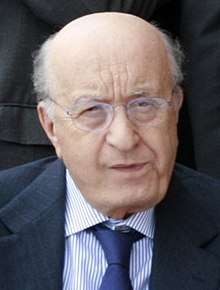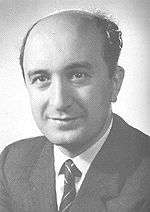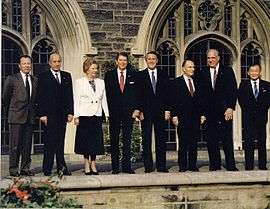Ciriaco De Mita
Luigi Ciriaco De Mita (Italian pronunciation: [tʃiˈriːako luˈiːdʒi de ˈmiːta]; born 2 February 1928)[1] is an Italian politician who served as the 47th Prime Minister of Italy from 1988 to 1989[2] and as Member of the European Parliament from 2009 to 2013.
Ciriaco De Mita | |
|---|---|
 | |
| 47th Prime Minister of Italy | |
| In office 13 April 1988 – 22 July 1989 | |
| President | Francesco Cossiga |
| Preceded by | Giovanni Goria |
| Succeeded by | Giulio Andreotti |
| Mayor of Nusco | |
| Assumed office 26 May 2014 | |
| Preceded by | Giuseppe De Mita |
| Minister for Interventions in Southern Italy | |
| In office 29 July 1976 – 20 March 1979 | |
| Prime Minister | Giulio Andreotti |
| Preceded by | Giulio Andreotti (by delegation of functions) |
| Succeeded by | Michele Di Giesi |
| Minister of Foreign Trade | |
| In office 23 November 1974 – 29 July 1976 | |
| Prime Minister | Aldo Moro |
| Preceded by | Gianmatteo Matteotti |
| Succeeded by | Rinaldo Ossola |
| Minister of Industry, Trade and craftsmanship | |
| In office 7 July 1973 – 23 November 1974 | |
| Prime Minister | Mariano Rumor |
| Preceded by | Mauro Ferri |
| Succeeded by | Carlo Donat-Cattin |
| Secretary of Christian Democracy | |
| In office May 1982 – February 1989 | |
| Preceded by | Flaminio Piccoli |
| Succeeded by | Arnaldo Forlani |
| Member of the Chamber of Deputies | |
| In office 28 April 1963 – 28 March 1994 | |
| In office 21 April 1996 – 14 April 2008 | |
| Personal details | |
| Born | 2 February 1928 Nusco, Campania, Kingdom of Italy |
| Nationality | Italian |
| Political party | Christian Democracy (1956–1994) Italian People's Party (1994–2002) The Daisy (2002–2007) Democratic Party (2007–2008) Union of the Centre (2008–2017) Italy is Popular (2017–present) |
| Spouse(s) | Anna Maria Scarinzi ( m. 1958) |
| Children | 4 |
| Relatives | Giuseppe De Mita (nephew) |
| Residence | Avellino, Campania |
| Alma mater | Catholic University of Milan |
Biography


Background and early career
De Mita was born in Nusco in the Avellinese hinterland. As a young man De Mita joined Christian Democracy and entered politics. He rose through the ranks of the party, becoming a member of its council in 1956, a member of Parliament in 1963 and a member of the Italian cabinet in 1973. During the next decade he served as Minister of Industry and then as Minister of Foreign Trade. De Mita became chairman of the party in 1982 at a time when its power was declining. He was re-elected in 1986 with 60% support from the party.
Prime Minister of Italy
After the elections of 1987, De Mita waited a year to become Prime Minister, and then served as Prime Minister for a year, maintaining the party chairmanship. At the beginning of that service, on 16 April 1988, in Forlì, Red Brigades killed Senator Roberto Ruffilli, an advisor of De Mita. In social policy, De Mita's time in office witnessed the passage of a law in May 1988 that introduced a new benefit for salaried workers called "benefit for the family nucleus" ("assegno per il nucleo familiare"), with the amount varying depending on the number of family members and the family income of the previous year.[3]
Later political roles
De Mita returned in Parliament, after a lag of two years, in 1996 (and then re-elected in 2001 and 2006). He then joined the Italian People's Party and later Democracy is Freedom - The Daisy, party of which he is regional coordinator for Campania. He headed the Olive Tree's list in his region in 2006, and he participated in the transformation that coalition into a single party (the Democratic Party). He joined the Union of the Centre. After the 2008 elections, De Mita was not elected at the Italian Senate, but he was nominated as the Campania coordinator of the party. De Mita won a seat in the European Parliament in the June 2009 European election. On 25 May 2014 De Mita was elected as mayor of Nusco, his native town.
Personal life
In 1958, De Mita married Anna Maria Scarinzi (born 12 February 1939), with whom he has one son and three daughters, Antonia (born 23 December 1967), Giuseppe (born 10 May 1969), Floriana (born 19 March 1973) and Simona (born 21 April 1974).[4][5]
References
- Moliterno, Gino (11 September 2002). "Encyclopedia of Contemporary Italian Culture". Routledge. Retrieved 29 August 2019 – via Google Books.
- Lentz, Harris M. (2014). Heads of States and Governments Since 1945. Routledge. pp. 446–447. ISBN 9781134264902. Retrieved 9 November 2014.
- European Observatory on Family Policies: National Family Policies in EC-Countries in 1990 by Wilfred Dumon in collaboration with Françoise Bartiaux, Tanja Nuelant, and experts from each of the member states
- Tutto al piano di sotto - Irpiniagate - goffredolocatelli.it
- Vespa, Bruno (29 August 2009). "L'amore e il potere. Da Rachele a Veronica, un secolo di storia italiana". Edizioni Mondadori. Retrieved 29 August 2019 – via Google Books.
| Political offices | ||
|---|---|---|
| Preceded by Mauro Ferri |
Minister of Industry, Trade and Craftsmanship 1973–1974 |
Succeeded by Carlo Donat-Cattin |
| Preceded by Gianmatteo Matteotti |
Minister of Foreign Trade 1974–1976 |
Succeeded by Rinaldo Ossola |
| Preceded by Giulio Andreotti |
Minister for Interventions in Southern Italy 1976–1979 |
Succeeded by Michele Di Giesi |
| Preceded by Giovanni Goria |
Prime Minister of Italy 1988–1989 |
Succeeded by Giulio Andreotti |
| Party political offices | ||
| Preceded by Flaminio Piccoli |
Secretary of Christian Democracy 1982–1989 |
Succeeded by Arnaldo Forlani |